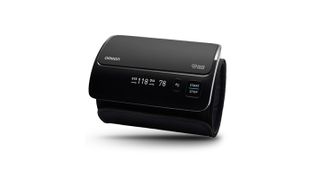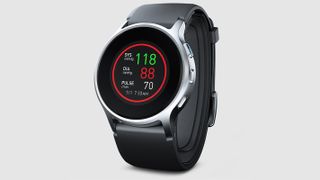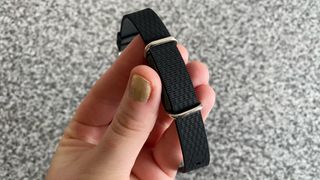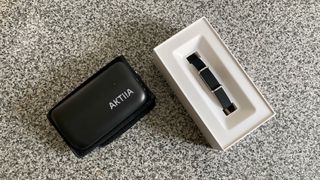Are wearables the future of blood pressure monitoring?
The pros and cons of measuring blood pressure from your wrist

It’s estimated that one in four men and one in five women around the world have high blood pressure, known as hypertension. This can put them at a higher risk of heart attack and stroke.
There are symptoms of hypertension, including headaches and vision changes, but many people don’t have any, which means diagnosis and treatment is often left too late. This is why it’s crucial that everyone has their blood pressure measured regularly – especially those who are high risk.
The standard way to detect hypertension is to use a blood pressure monitor cuff or, more officially, a sphygmomanometer. This is a cuff that’s attached to a small device with a screen. The cuff is worn on your upper arm and tightens to restrict bloodflow. This allows pressure sensors inside to measure the strength with which your blood pushes on your arteries as it’s pumped around your body – your blood pressure.
This method is relatively easy and accurate, so why do we need new solutions?
The problems with blood pressure monitoring
Experts recommend people with hypertension measure their blood pressure twice a day. But a 2020 survey from wearable sensor company Valencell found that 31 per cent of US adults with hypertension measure their blood pressure only once a month, another 31 per cent admit to measuring it once a year. This could be because patients forget, don’t have the equipment they need at hand or there’s a lack of resources.
“We often don’t have time or ability to perform perfectly accurate blood pressure readings or frequent blood pressure readings,” says Dr Jordana Cohen, an Assistant Professor of Medicine and Epidemiology at the University of Pennsylvania who specializes in hypertension research.
For example, if a patient starts a new medication they’d ideally need to take multiple readings on the same day and over the next few days to assess how they respond – but this often isn’t possible.
Get daily insight, inspiration and deals in your inbox
Get the hottest deals available in your inbox plus news, reviews, opinion, analysis and more from the TechRadar team.
Dr Cohen explains there are also a number of specific conditions to consider that make traditional blood pressure monitoring imperfect. These include white coat hypertension, which is when someone’s blood pressures are elevated around doctors, but not at home. Masked hypertension, when readings might be fine in a doctor’s office but elevated at home. Or nocturnal hypertension, which is when blood pressures are elevated while sleeping.

You could buy one of the standard cuff blood pressure monitors for use at home. This is the reality for many people currently living with hypertension and there are a range of options available to buy, like the top-performing Omron Evolv ($89.99 / £96.02, about AU$120).
Those with ongoing hypertension might also need what’s called ambulatory blood pressure monitoring (ABPM). This is when a doctor provides them with a portable blood pressure monitor with a cuff throughout the day. The cuff takes a reading every half an hour or so and stores them for later.
But cuff blood pressure monitoring, whether in a health setting or at home, isn’t convenient for many reasons: it can’t be taken at night, might elevate blood pressure levels when the cuff inflates and could be difficult to wear during the day for those who work, are on-the-move, disabled people or older adults.
This is why wearable tech companies are developing methods that could make a reading as simple and unobtrusive as wearing a fitness tracker-style device on your wrist that takes measurements throughout the day – less stress, no cuff.
Understanding cuffless blood pressure monitoring
Dr Ghalib Janjua, a lecturer in electronic and electrical engineering at Robert Gordon University who specializes in bioengineering and cuffless blood pressure monitoring, tells me there are already a number of cuffless monitoring solutions being researched and developed. These use a number of different metrics, including pulse arrival time, pulse transit time, pulse wave analysis and pulse wave velocity.
However, Dr Janjua warns: “these are all limited in accuracy and require frequent calibration against the sphygmomanometer devices.” This means that athough some devices are able to take cuffless readings right now, you also need a device with a cuff – a sphygmomanometer device – to check their accuracy regularly.
Only recently have some of these methods been developed in ways that make cuffless blood pressure monitoring a viable option for us all to carry out at home. Most of these make use of the PPG (that’s photoplethysmography) sensor you can find on the underside of an Apple Watch or Fitbit Versa that’s usually used to track heart rate. But it can also take optical readings of your arteries to estimate blood pressure.

Search Amazon and you’ll find a number of different wearables and fitness trackers that claim to be able to use a PPG sensor to track your blood pressure. However, many of these are estimations and aren’t certified medical devices but instead lifestyle wearables aimed at building a general picture of your overall health – not diagnosing serious problems. But all that could soon change.
One significant example of this technology stepping up comes from a recent update to the Samsung Health Monitor app. This now allows you to use the PPG sensor already in your Samsung Galaxy Watch 3 or Galaxy Watch Active to take a blood pressure reading.
This is a spot check, which means you decide when you want to take one – it doesn’t happen automatically like tracking your heart rate. Although this does need to be checked against a cuff reading every so often.
There have been lots of rumours that other wearable brands, including Fitbit and Apple, might soon introduce similar features. This could mean using data from PPG sensors, like Samsung, or using similar pressure sensor technology found in a blood monitor cuff. For example, in 2020 Apple registered a patent that described how to measure blood pressure using pressure sensors in the wristband of a wearable.
It’s also worth knowing that cuff-based blood pressure measuring has had a wearable upgrade. Take the Omron HeartGuide as a best-in-class example. This does use a cuff, it’s just very small and within the strap of a fairly slim wearable, which makes it look like a smartwatch. At $499/£499 (about AU$650), the cost of this device is quite prohibitive, but it’s from top health tech company Omron and can provide accurate, on-the-spot blood pressure readings when you ask it to.

Aktiia: is 24/7 blood pressure monitoring possible?
Aktiia is a new addition to the wearable blood pressure monitoring space (it’s available to pre-order now for £159.99 in the UK with international availability coming soon). This is a cuffless device that’s worn around your wrist.
We’ve had a hands-on with a sample unit of the Aktiia and can confirm it’s even slimmer than a fitness tracker and more comfortable too – the big difference is it doesn’t have a screen. I love seeing data in real-time, but understand why a more subtle approach is not only more appealing for a wider audience but lessens the anxiety some people feel when thinking about and taking their blood pressure.

Aktiia takes a blood pressure reading around every 90 minutes during the day and throughout the night using a PPG sensor. The results are then sent to your phone, where you can look at them. You do need a cuff for initial set-up – this comes in the box with the Aktiia – to ensure everything is working correctly, but the idea is you’d rarely need one to ‘check’ Aktiia’s readings after that.

We know that devices with a cuff work by constricting blood flow in order to analyse the pulse that travels along your arteries. Aktiia’s technology does the same thing – but without the cuff.
“Our technology also analyses pulse waves traveling along the arteries to generate estimations of blood pressure,” Dr Josep Sola, founder and CTO of Aktiia tells me. “But instead of using pressure sensors, Aktiia's algorithms leverage optical sensors that analyse the changing diameter of the arteries at the wrist.”
One of the main benefits of Aktiia is that readings are taken continuously. This means there’s no worrying about your readings, which might cause blood pressure levels to elevate. You don’t need to press a button, sit still or even be awake for it to work.

“It helps physicians make a more accurate diagnosis, provide more tailored treatment plans and evaluate the efficacy of therapy,” Dr Sola tells me. He also explains 24/7 measuring can give people real-time insights into the impact what they eat, how often they work out, how well they sleep and how they manage stress has on their blood pressure.
Aktiia has big ambitions. “Aktiia’s goal is to help 100 million people over the next 10 years better understand and manage their blood pressure,” Dr Sola tells me. Although the primary goal is selling people a new device, the data it collects could have a bigger, positive impact. “We are building the largest, longitudinal, 24/7 blood pressure dataset in the world, which will enable significant improvements to the current standard of care, including diagnosis, treatment and monitoring,” Dr Sola says.
What’s more, Aktiia’s tech might soon be used more widely. Although no details are concrete yet, Dr Sola tells me the team is in talks to bring its software and services to more third-party wearables.

How accurate is cuffless blood pressure monitoring?
The future is promising for Aktiia. It’s now officially classed as a medical device, which means it meets health and safety standards in Europe.
But the big question concerning not only Aktiia, but every cuffless blood pressure monitoring device in development is: how accurate are they?
“Aktiia and all existing cuff-based blood pressure monitors generate estimations of blood pressure, instead of directly measuring it,” says Dr Sola.
However, devices designed to be worn on your wrist could present problems. The American Heart Association currently only recommends that blood pressure readings are taken from the upper arm. Other places, like your wrist or your finger, it claims, might not be as accurate.
“In clinical settings, blood pressure is measured whilst the subject is in a stationary seated posture, which keeps the blood pressure constant in the brachial artery,” Dr Janjua explains. “In the wearable device, the signal is acquired at the radial artery at the wrist and/or finger location, which is lower than the heart level and can result in hydrostatic variation. These variations cause poor blood pressure estimation.”
A blood pressure monitor you wear might feel more convenient and allow you to collect more readings, but taking these measurements from your wrist could mean they’re not as accurate.
What’s more, cuffless monitors might already be at a disadvantage. “Without the cuff, many assumptions need to be made by device algorithms to try to estimate what the results of using a cuff might have shown,” says Dr Jordana Cohen.
“While upcoming technologies may be able to eventually overcome this challenge, we need careful studies to be performed to ensure that they are consistently valid in a wide range of patients, using appropriate and rigorous methods that are developed by experts in this area,” says Dr Jordana Cohen. “Including those who do not stand to profit from sales of these devices.”
The answer? More testing, more data collection and more validation. There are lots of different international organizations that determine whether a device can be used to accurately assess blood pressure and they will all need to be shown that cuffless, wearable devices are as accurate as they claim. This might happen soon, but patience and precision is important.
“While these may prove to be an exciting and helpful new way to monitor blood pressure in the future, we need to be mindful of the dangers of acting on blood pressure readings that could be highly inaccurate,” says Dr Cohen. “People’s hypertension can end up significantly over- or under-treated, potentially resulting in serious harm.”

The future of blood pressure monitoring tech
Could these technologies take over cuff-based blood pressure monitoring? The experts I spoke to were both hopeful yet cautious. “This is the beginning of a modernization of century old technology,” Dr Janjua says. “It’s an area which is showing encouraging results.”
Home solutions address accuracy concerns by encouraging people to check readings on both a cuffless and cuff-based device. But expecting people to own and use two separate methods feels more inaccessible, not less.
So don’t throw away your cuff-based blood pressure monitor just yet. But we wouldn’t be surprised to see more Aktiia devices in the not-so-distant future, as well as more blood pressure monitoring smarts coming to a wearable near you.
- We've rounded up the best running watches you can buy today
Becca is a contributor to TechRadar, a freelance journalist and author. She’s been writing about consumer tech and popular science for more than ten years, covering all kinds of topics, including why robots have eyes and whether we’ll experience the overview effect one day. She’s particularly interested in VR/AR, wearables, digital health, space tech and chatting to experts and academics about the future. She’s contributed to TechRadar, T3, Wired, New Scientist, The Guardian, Inverse and many more. Her first book, Screen Time, came out in January 2021 with Bonnier Books. She loves science-fiction, brutalist architecture, and spending too much time floating through space in virtual reality.

